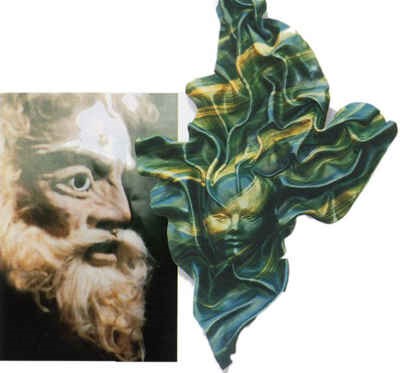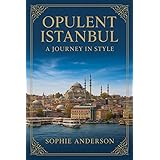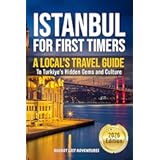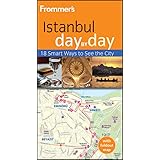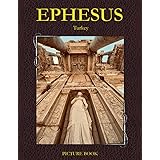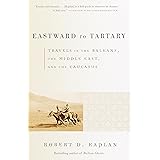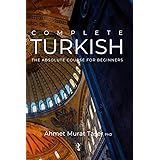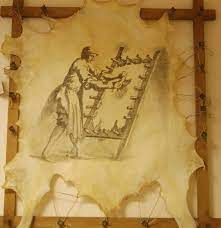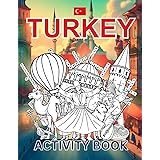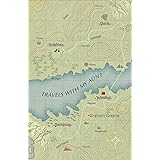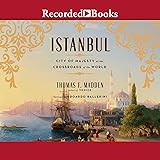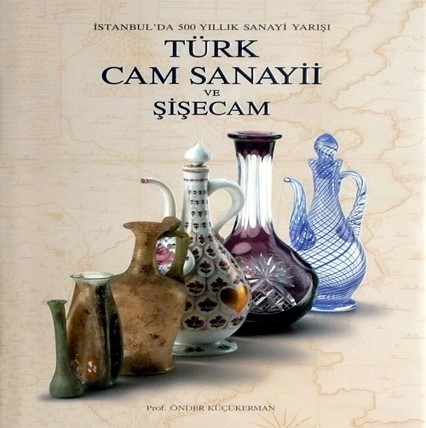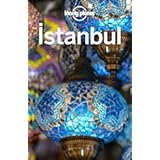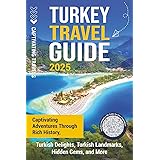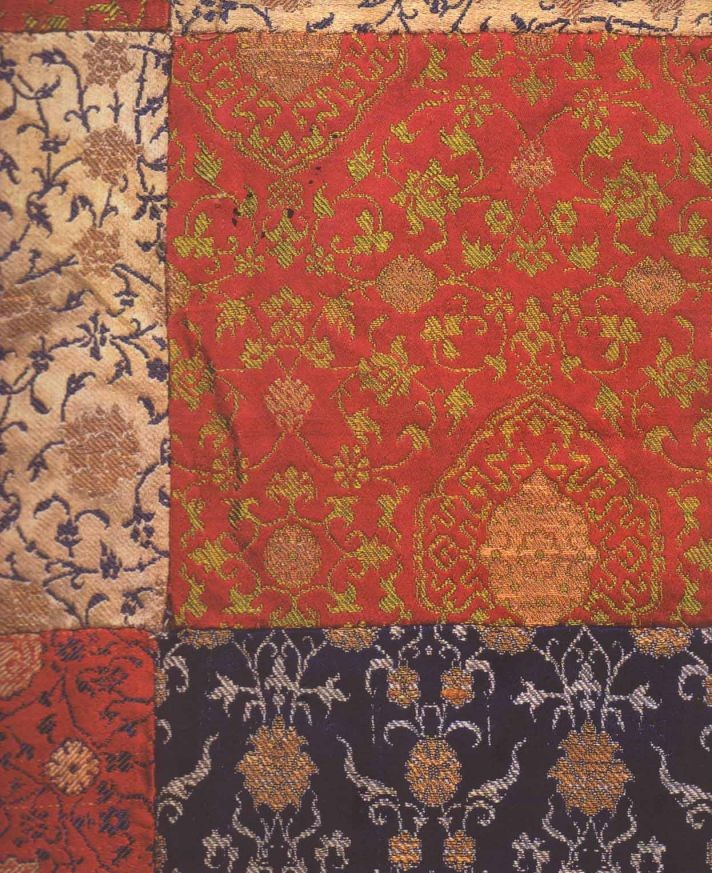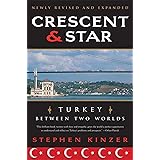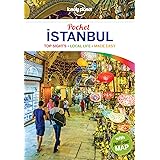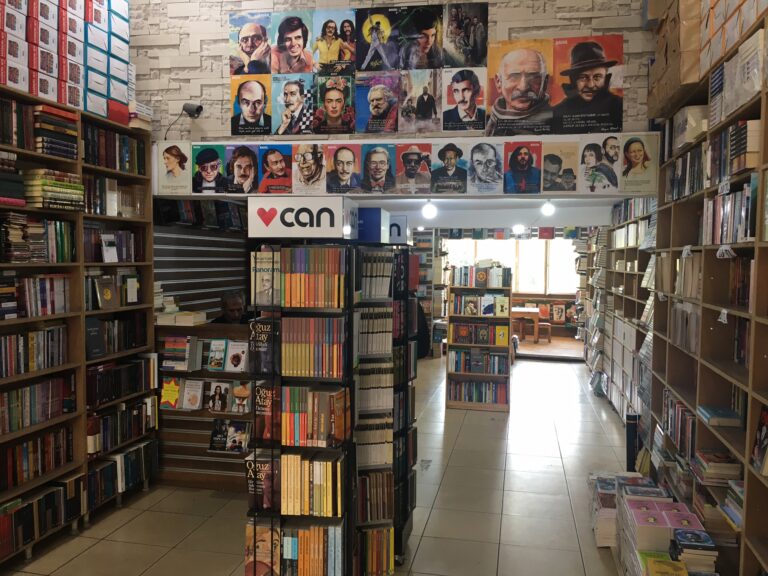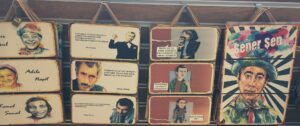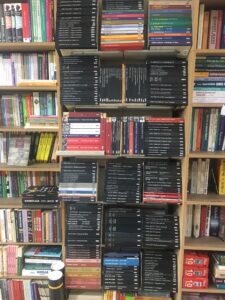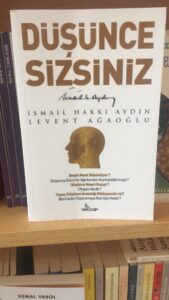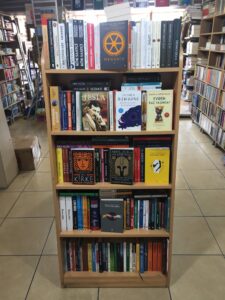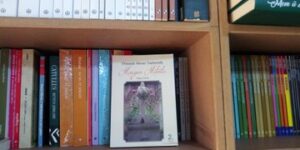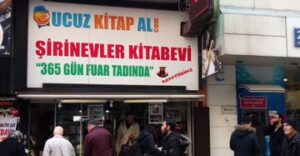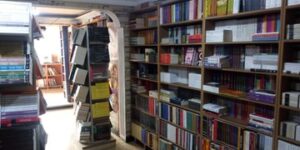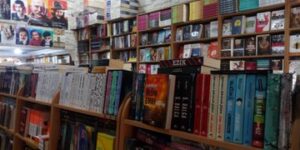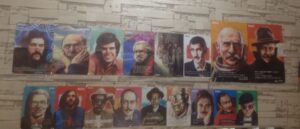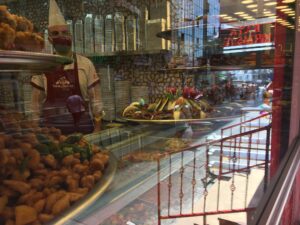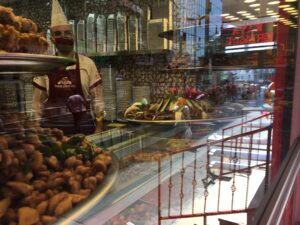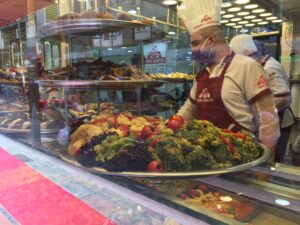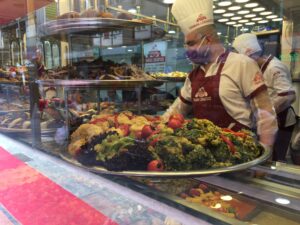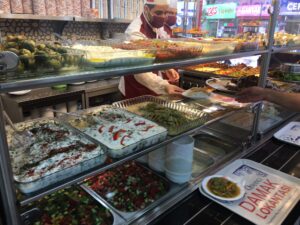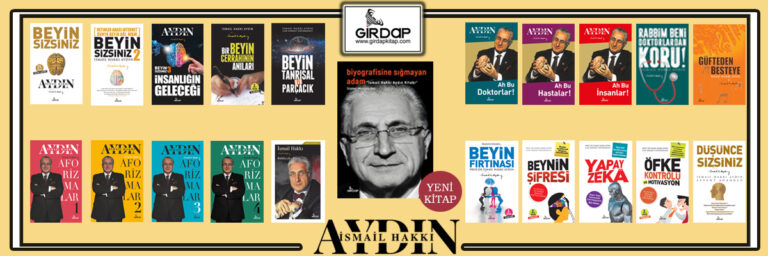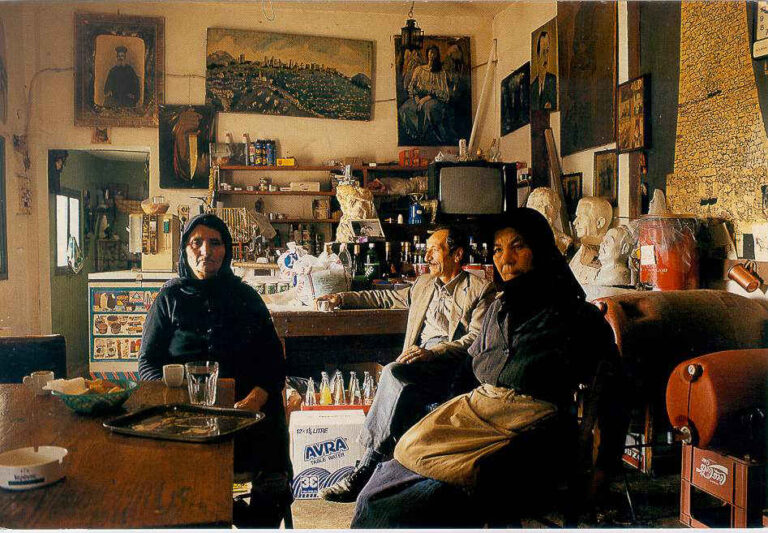-
Diogenes
-
Epictetus
-
Hippocrates
-
Homeros
-
Strabo
-
Xenophon
Tragedy
Yet another ancient reference for leather is the famous Greek Theatre where, especially in the major tragedy plays, the actors carried or wore masks, and often clothing, made from goat skins. The word tragedy itself derived from the Greek tragoidia, tragos = goat and ode = song and indicates that cloth and masks were using goat skins, raw, but cleaned and also used hair-on. For garments it would have been softened but for masks the skin would have dried on a model, for the face or the whole head, shaved in those parts where the skin should be visible, but keeping the hair for the head and beard. The different goat skins allowed white hair for the philosopher, for instance, or black, wild hair for villain. Even today, many Venetian masks are still made using leather.
Actor’s Mask
Iliad, the Odyssey
Expressions in Illiada and Odissea indicate in detail the fields in which Anatolians have used leather. It is possible to read in this valuable book the stories of leather used in such fields as clothing products, household goods, vessels, war tools, hunting devices, tents, horse harnesses, agricultural items, transport supplies, musical instruments, sports games, punitive vehicles, parchment.
A wild ox’s hide was spread beneath
And a beautiful kilim beneath the head (the Iliad)
So he said and prepared a bed for him
Spreading the sheep and goat hide next to the fire
Odyssey laid down on the bed, and the shepherd threw the wooden cloth on him. (the Odyssey)
In Odyssey and the Iliad of Homer, the outfits of the characters have been described in detail from which we understand hides of various animals were used as clothes in the antique period.
|
|
|
Shoe production depicted on a Greek vase |
Ilyada, Homeros
book 7, card 2: Hom. Il. 7.2
And Hektor answered, “Noble Ajax, son of Telamon, leader of the host, treat me not as though I were some puny boy or woman that cannot fight.
I have been long used to the blood and butcheries of battle. I am quick to turn my leather shield either to right or left, for this I deem the main thing in battle. I can charge among the chariots and horsemen, and in hand to hand fighting can delight the heart of Ares; howbeit I would not take such a man as you are off his guard – but I will smite you openly if I can.”
He poised his spear as he spoke, and hurled it from him. It struck the sevenfold shield in its outermost layer – the eighth, which was of bronze – and went through six of the layers but in the seventh hide it stayed. Then Ajax threw in his turn, and struck the round shield of the son of Priam. The terrible spear went through his gleaming shield, and pressed onward through his cuirass of cunning workmanship; it pierced the shirt against his side, but he swerved and thus saved his life. They then each of them drew out the spear from his shield, and fell on one another like savage lions or wild boars of great strength and endurance: the son of Priam struck the middle of Ajax’s shield, but the bronze did not break, and the point of his dart was turned. Ajax then sprang forward and pierced the shield of Hektor; the spear went through it and staggered him as he was springing forward to attack; it gashed his neck and the blood came pouring from the wound, but even so Hektor did not cease fighting; he gave ground, and with his brawny hand seized a stone, rugged and huge, that was lying upon the plain; with this he struck the shield of Ajax on the boss that was in its middle, so that the bronze rang again. But Ajax in turn caught up a far larger stone, swung it aloft, and hurled it with prodigious force. This millstone of a rock broke Hektor’s shield inwards and threw him down on his back with the shield crushing him under it,
book 10, card 2: Hom. Il. 10.2
“Son of Tydeus,” replied Odysseus, “say neither good nor ill about me, for you are among Argives who know me well. Let us be going, for the night wanes and dawn is at hand. The stars have gone forward, two-thirds of the night are already spent, and the third is alone left us.”
They then put on their armor. Brave Thrasymedes provided the son of Tydeus with a sword and a shield (for he had left his own at his ship) and on his head he set a helmet of bull’s hide without either peak or crest; it is called a skull-cap and is a common headgear. Meriones found a bow and quiver for Odysseus, and on his head he set a leather helmet that was lined with a strong plaiting of leather thongs, while on the outside it was thickly studded with boar’s teeth, well and skillfully set into it; next the head there was an inner lining of felt. This helmet had been stolen by Autolykos out of Eleon when he broke into the house of Amyntor son of Ormenus. He gave it to Amphidamas of Cythera to take to Scandea, and Amphidamas gave it as a guest-gift to Molos, who gave it to his son Meriones; and now it was set upon the head of Odysseus.
book 12, card 1:
Then Zeus the lord of thunder sent the blast of a mighty wind from the mountains of Ida, that bore the dust down towards the ships; he thus lulled the thinking [noos] of the Achaeans into security, and gave victory to Hektor and to the Trojans, who, trusting to their own might and to the signs he had shown them, essayed to break through the great wall of the Achaeans. They tore down the breastworks from the walls, and overthrew the battlements; they upheaved the buttresses, which the Achaeans had set in front of the wall in order to support it; when they had pulled these down they made sure of breaking through the wall, but the Danaans still showed no sign of giving ground; they still fenced the battlements with their shields of ox-hide, and hurled their missiles down upon the foe as soon as any came below the wall.
book 13, card 1:
thereon he shouted to the Trojans, “Trojans, Lycians, and Dardanians, fighters in close combat, stand firm: the Achaeans have set themselves as a wall against me, but they will not check me for long; they will give ground before me if the mightiest of the gods, the thundering spouse of Hera, has indeed inspired my onset.”
With these words he put heart and soul into them all. Deiphobos son of Priam went about among them intent on deeds of daring with his round shield before him, under cover of which he strode quickly forward. Meriones took aim at him with a spear, nor did he fail to hit the broad orb of ox-hide; but he was far from piercing it for the spear broke in two pieces long ere he could do so; moreover Deiphobos had seen it coming and had held his shield well away from him. Meriones drew back under cover of his comrades, angry alike at having failed to vanquish Deiphobos, and having broken his spear. He turned therefore towards the ships and tents to fetch a spear which he had left behind in his tent.
book 16, card 3:
Meanwhile great Ajax kept on trying to drive a spear into Hektor, but Hektor was so skillful that he held his broad shoulders well under cover of his ox-hide shield, ever on the look-out for the whizzing of the arrows and the heavy thud of the spears. He well knew that the fortunes of the day had changed, but still stood his ground and tried to protect his comrades.
book 16, card 5:,
On this the son of Menoitios rebuked him and said, “Meriones, hero though you be, you should not speak thus; taunting speeches, my good friend, will not make the Trojans draw away from the dead body; some of them must go under ground first; the outcome [telos] of battle is in the force of hands, while the outcome of deliberation is words; fight, therefore, and say nothing.”
He led the way as he spoke and the hero went forward with him. As the sound of woodcutters in some forest glade upon the mountains- and the thud of their axes is heard afar – even such a din now rose from earth-clash of bronze armor and of good ox-hide shields, as men smote each other with their swords and spears pointed at both ends.
book 17, card 3:
Thus through the livelong day did they wage fierce war, and the sweat of their toil rained ever on their legs under them, and on their hands and eyes, as they fought over the squire [therapôn] of the fleet son of Peleus. It was as when a man gives a great ox-hide all drenched in fat to his men, and bids them stretch it; whereon they stand round it in a ring and tug till the moisture leaves it, and the fat soaks in for the many that pull at it, and it is well stretched –
even so did the two sides tug the dead body hither and thither within the compass of but a little space – the Trojans steadfastly set on dragging it into Ilion, while the Achaeans were no less so on taking it to their ships; and fierce was the fight between them. Not Ares himself the lord of hosts, nor yet Athena, even in their fullest fury could make light of such a battle.
book 17, card 4:
The valiant son of Anchises was of the same mind, and the pair went right on, with their shoulders covered under shields of tough dry ox-hide, overlaid with much bronze. Chromios and Aretos went also with them, and their hearts beat high with hope that they might kill the men and capture the horses – fools that they were, for they were not to return scatheless from their meeting with Automedon, who prayed to father Zeus and was forthwith filled with courage and strength abounding.
book 18, card 5:
Two terrible lions had fastened on a bellowing bull that was with the foremost cows, and bellow as he might they haled him, while the dogs and men gave chase: the lions tore through the bull‘s thick hide and were gorging on his blood and bowels, but the herdsmen were afraid to do anything, and only hounded on their dogs; the dogs dared not fasten on the lions but stood by barking and keeping out of harm’s way.
The god wrought also a pasture in a fair mountain dell, and large flock of sheep, with a homestead and huts, and sheltered sheepfolds.
book 22, card 1:
Here, hard by the springs, are the goodly washing-troughs of stone, where in the time of peace before the coming of the Achaeans the wives and fair daughters of the Trojans used to wash their clothes. Past these did they flee, the one in front and the other giving chase behind him: good was the man that fled,
but better far was he that followed after, and swiftly indeed did they run, for the prize was no mere beast for sacrifice or bullock’s hide, as it might be for a common foot-race, but they ran for the life [psukhê] of Hektor. As horses in a chariot race speed round the turning-posts when they are running for some great prize [athlon] – a tripod or woman – at the games in honor of some dead hero, so did these two run full speed three times round the city of Priam. All the gods watched them, and the sire of gods and men was the first to speak.
book 22, card 3:
Now, therefore, Achaean youths, let us raise the song of victory and go back to the ships taking this man along with us; for we have achieved a mighty triumph and have slain noble Hektor to whom the Trojans prayed throughout their city as though he were a god.”
On this he treated the body of Hektor with contumely: he pierced the sinews at the back of both his feet from heel to ankle and passed thongs of ox-hide through the slits he had made: thus he made the body fast to his chariot, letting the head trail upon the ground. Then when he had put the goodly armor on the chariot and had himself mounted, he lashed his horses on and they flew forward nothing loath. The dust rose from Hektor as he was being dragged along, his dark hair flew all abroad, and his head once so comely was laid low on earth, for Zeus had now delivered him into the hands of his foes to do him outrage in his own land.
book 23, card 6:
They all held their peace, and no man rose save Euryalos son of Mekisteus, who was son of Talaos. Mekisteus went once to Thebes after the fall of Oedipus, to attend his funeral, and he beat all the people of Cadmus. The son of Tydeus was Euryalos’ second, cheering him on and hoping heartily that he would win. First he put a waistband round him and then he gave him some well-cut thongs of ox-hide; the two men being now girt went into the middle of the ring [agôn], and immediately fell to; heavily indeed did they punish one another and lay about them with their brawny fists. One could hear the horrid crashing of their jaws, and they sweated from every pore of their skin. Presently Epeios came on and gave Euryalos a blow on the jaw as he was looking round; Euryalos could not keep his legs; they gave way under him in a moment and he sprang up with a bound, as a fish leaps into the air near some shore that is all bestrewn with sea-wrack, when Boreas furs the top of the waves, and then falls back into deep water. But noble Epeios caught hold of him and raised him up; his comrades also came round him and led him from the ring [agôn], unsteady in his gait, his head hanging on one side, and spitting great clots of gore. They set him down in a swoon and then went to fetch the double cup.
book 7, card 2: |
The Argives were elated as they beheld him, but the Trojans trembled in every limb, and the heart even of Hektor beat quickly, but he could not now retreat and withdraw into the ranks behind him, for he had been the challenger. Ajax came up bearing his shield in front of him like a wall – a shield of bronze with seven folds of oxhide – the work of Tychios, who lived in Hyle and was by far the best worker in leather. He had made it with the hides of seven full-fed bulls, and over these he had set an eighth layer of bronze. Holding this shield before him, Ajax son of Telamon came close up to Hektor, and menaced him saying, “Hektor, you shall now learn, man to man, what kind of champions the Danaans have among them even besides lion-hearted Achilles cleaver of the ranks of men. He now abides at the ships in anger with Agamemnon shepherd of his people, but there are many of us who are well able to face you; therefore begin the fight.”
book 10, card 6:
He laughed as he spoke and drove the horses over the ditch, while the other Achaeans followed him gladly. When they reached the strongly built quarters of the son of Tydeus, they tied the horses with thongs of leather to the manger, where the steeds of Diomedes stood eating their sweet grain, but Odysseus hung the blood-stained spoils of Dolon at the stern of his ship, that they might prepare a sacred offering to Athena. As for themselves, they went into the sea and washed the sweat from their bodies, and from their necks and thighs. When the sea-water had taken all the sweat from off them, and had refreshed them, they went into the baths and washed themselves. After they had so done and had anointed themselves with oil, they sat down to table, and drawing from a full mixing-bowl, made a drink-offering of wine to Athena.
book 10, card 1:
On this Odysseus went at once into his tent, put his shield about his shoulders and came out with them. First they went to Diomedes son of Tydeus, and found him outside his tent clad in his armor with his comrades sleeping round him and using their shields as pillows; as for their spears,
they stood upright on the spikes of their butts that were driven into the ground, and the burnished bronze flashed afar like the lightning of father Zeus. The hero was sleeping upon the skin of an ox, with a piece of fine carpet under his head; Nestor went up to him and stirred him with his heel to rouse him, upbraiding him and urging him to bestir himself. “Wake up,” he exclaimed, “son of Tydeus. How can you sleep on in this way? Can you not see that the Trojans are encamped on the brow of the plain hard by our ships, with but a little space between us and them?”
book 10, card 2:
Diomedes threw the skin of a great tawny lion about his shoulders – a skin that reached his feet – and grasped his spear. When he had roused the heroes, he brought them back with him; they then went the round of those who were on guard, and found the leaders not sleeping at their posts but wakeful and sitting with their arms about them. As sheep dogs that watch their flocks when they are yarded, and hear a wild beast coming through the mountain forest towards them – forthwith there is a hue and cry of dogs and men, and slumber is broken – even so was sleep chased from the eyes of the Achaeans as they kept the watches of the wicked night, for they turned constantly towards the plain whenever they heard any stir among the Trojans.
book 10, card 3:
When he had done speaking Hektor held up his scepter, and swore him his oath saying, “May Zeus the thundering husband of Hera bear witness that no other Trojan but yourself shall mount those steeds, and that you shall have your will with them for ever.”
The oath he swore was bootless, but it made Dolon more keen on going. He hung his bow over his shoulder, and as an overall he wore the skin of a gray wolf, while on his head he set a cap of ferret skin. Then he took a pointed javelin, and left the camp for the ships, but he was not to return with any news for Hektor.
book 10, card 5:
Diomedes looked sternly at him and answered, “Think not, Dolon, for all the good information you have given us, that you shall escape now you are in our hands, for if we ransom you or let you go, you will come some second time to the ships of the Achaeans either as a spy or as an open enemy, but if I kill you and an end of you, you will give no more trouble.”
On this Dolon would have caught him by the beard to beseech him further, but Diomedes struck him in the middle of his neck with his sword and cut through both sinews so that his head fell rolling in the dust while he was yet speaking. They took the ferret-skin cap from his head, and also the wolf-skin, the bow, and his long spear. Odysseus hung them up aloft in honor of Athena the goddess of plunder, and prayed saying, “Accept these, goddess, for we give them to you in preference to all the gods in Olympus: therefore speed us still further towards the horses and sleeping-ground of the Thracians.”
book 12, card 2:
Still the Trojans and brave Hektor would not yet have broken down the gates and the great bar, had not Zeus turned his son Sarpedon against the Argives as a lion against a herd of horned cattle. Before him he held his shield of hammered bronze, that the smith had beaten so fair and round, and had lined with ox hides which he had made fast with rivets of gold all round the shield;
this he held in front of him, and brandishing his two spears came on like some lion of the wilderness, who has been long famished for want of meat and will dare break even into a well-fenced homestead to try and get at the sheep.
book 13, card 7:
They flew forth like the blasts of some fierce wind that strike earth in the van of a thunderstorm – they buffet the salt sea into an uproar; many and mighty are the great waves that come crashing in one after the other upon the shore with their arching heads all crested with foam – even so did rank behind rank of Trojans arrayed in gleaming armor follow their leaders onward. The way was led by Hektor son of Priam, peer of murderous Ares, with his round shield before him – his shield of ox-hides covered with plates of bronze – and his gleaming helmet upon his temples. He kept stepping forward under cover of his shield in every direction, making trial of the ranks to see if they would give way be him, but he could not daunt the courage of the Achaeans. Ajax was the first to stride out and challenge him. “Sir,” he cried, “draw near; why do you think thus vainly to dismay the Argives? We Achaeans are excellent warriors, but the scourge of Zeus has fallen heavily upon us. Your heart, indeed, is set on destroying our ships,
but we too have bands that can keep you at bay, and your own fair town shall be sooner taken and sacked by ourselves.
book 16, card 5:
He led the way as he spoke and the hero went forward with him. As the sound of woodcutters in some forest glade upon the mountains- and the thud of their axes is heard afar – even such a din now rose from earth-clash of bronze armor and of good ox-hide shields, as men smote each other with their swords and spears pointed at both ends. A man had need of good eyesight now to know Sarpedon, so covered was he from head to foot with spears and blood and dust.
Epictetus, Discourses |
More(2) |
(English) (English, ed. George Long) (Greek) |
|
text disc, book 1, chapter 20: … itself. The art of Shoemaking, for instance, is exercised upon leather, but is itself entirely distinct from the materials itEvery art, and every faculty, contemplates certain things as its principal objects. Whenever, therefore, it is of the same nature with the objects of its contemplation, it necessarily contemplates itself too; but where it is of a different nature, it cannot contemplate itself. The art of Shoemaking, for instance, is exercised upon leather, but is itself entirely distinct from the materials it works upon; therefore it does not contemplate itself. Again, grammar is exercised on articulate speech. Is the art of grammar itself, then, articulate speech? By no means. Therefore, it cannot contemplate itself. To what purpose, then, is reason appointed by nature? To a proper use of the phenomena of existence. And what is reason? The art of systematizing these phenomena. Thus, by its nature, it becomes contemplative of itself too.text disc, book 3, chapter 22:In the first place, then, you must purify your own ruling faculty, to match this method of life. Now, the material for me to work upon is my own mind, as wood is for a carpenter, or leather for a Shoemaker; and my business is a right use of things as they appear. But body is nothing to me; its parts nothing to me. Let death come when it will, either of the whole body or of part. “Go into exile.” And whither? Can any one turn me out of the universe? He cannot. But wherever I go there is the sun, the moon, the stars, dreams, auguries, communication with God. And even this preparation is by no [2067] means sufficient for a true Cynic. But it must further be known that he is a messenger sent from Zeus to men, concerning good and evil; to show them that they are mistaken, and seek the essence of good and evil where it is not, but do not observe it where it is; that he is a spy, like Diogenes, when he was brought to Philip after the battle of Chaeronea. For, in effect, a Cynic is a spy to discover what things are friendly, what hostile, to man; and he must, after making an accurate observation, come and tell them the truth; not be struck with terror, so as to point out to them enemies where there are none; nor, in any other instance, be disconcerted or confounded by appearances. |
|
Hippocrates, De articulis |
More(9) |
|||||||||||
(English) (Greek, ed. A. Littre) |
||||||||||||
text Art., section 3: …
Dislocation inward at the hip-joint is to be reduced in the following manner: (it is a good, proper, and natural mode of reduction, and has something of display in it, if any one takes delight in such ostentatious modes of procedure). The patient is to be suspended by the feet from a cross-beam with a strong, soft, and broad cord; the feet are to be about four inches or less from one another; and a broad and soft leather collar connected with the cross-beam is to be put on above the knees; and the affected leg should be so extended as to moved be two inches longer than the other; the head should be about two cubits from the ground, or a little more or less; and the arms should be stretched along the sides, and bound with something soft; all these preparations should be made while he is lying on his back, so that he may be suspended for as short a time as possible. |
||||||||||||
text Art., section 3: … small and hard balls, formed from several pieces of leather sewed together. For without something of the kind the |
||||||||||||
text Art., section 30: … laid on his back, and his head supported on a leather cushion well filled, so that it may yield as |
||||||||||||
text Art., section 33: … description given. Then one must take a piece of Carthaginian leather; if the patient be a younger person, it will |
||||||||||||
text Art., section 37: … in a piece of cloth, or rather stitched in Carthaginian leather, and moulded into a shape suitable to the place |
||||||||||||
text Art., section 38: … if introduced, imbibe humidities. Then the outer skin of Carthaginian leather is to be taken, and a piece of the |
||||||||||||
text Art., section 43: … following manner:-The ladder is to be padded with leather lined cushions, laid across, and well secured to one |
||||||||||||
text Art., section 47: … broad and long, and composed of two cross straps of leather, is to be twice carried along the middle of … hole, then a rag, folded several times or a small leather cushion, should be laid on the hump; nothing large |
||||||||||||
text Art., section 62: … to incline a little outward. And a sole made of leather not very hard, or of lead, is to be |
||||||||||||
text Art., section 70: … less from one another; and a broad and soft leather collar connected with the cross-beam is to be |
||||||||||||
Hippocrates, De fracturis |
More(3) |
|||||||||||
(English) (Greek, ed. A. Littre) |
||||||||||||
text Fract., section 8: … then having brought another seat, and placed one or more leather pillows under the arm, so as to keep itWhen the arm is broken, if one stretch the fore-arm and adjust it while in this position, the muscle of the arm will be bound while extended; but when the dressing is over, and the patient bends his arm at the elbow, the muscle of the arm will assume a different shape. The following, then, is the most natural plan of setting the arm: having got a piece of wood a cubit or somewhat less in length, like the handles of spades, [179] suspend it by means of a chain fastened to its extremities at both ends; and having seated the man on some high object, the arm is to be brought over, so that the armpit may rest on the piece of wood, and the man can scarcely touch the seat, being almost suspended; then having brought another seat, and placed one or more leather pillows under the arm, so as to keep it a moderate height while it is bent at a right angle, the best plan is to put round the arm a broad and soft skin, or broad shawl, and to hang some great weight to it, so as to produce moderate extension; or otherwise, while the arm is in the position I have described, a strong man is to take hold of it at the elbow and pull it downward.text Fract., section 13:Or thus, if you prefer it: having bound other thongs of leather about the limb, either at the knee, or around the thigh, and having fastened another nave of a wheel in the ground above the head, and adjusted the thongs piece of wood adapted to the nave, extension may thus be made in the opposite direction to the feet. Or if you choose, it may be done thus: instead of the naves, lay a moderate-sized beam under the couch, and then having fastened pieces of wood in this beam, both before and behind the head, make counter-extension by means of thongs, or place windlasses at this extremity and that, and make extension by means of them. There are many other methods of making extension. But the best thing is, for any physician who practices in a large city, to have prepared a proper wooden machine, with all the mechanical powers applicable in cases of fractures and dislocation, either for making extension, or acting as a lever. For this purpose it will be sufficient to possess a board in length, breadth, and thickness, resembling the quadrangular threshing-boards made of oak.text Fract., section 30:For if it had not been bound it would have been less distorted, as it would have been the less prevented from following the motion of the rest of the body. But one should sew two balls of Egyptian leather, such as are worn by persons confined for a length of time in large shackles, and the balls should have coats on each side, deeper toward the wound, but shorter toward the joints; and the balls should be well stuffed and soft, and fit well, the one above the [198] ankles, and the other below the knee. |
||||||||||||
Diogenes Laertius, Lives of Eminent Philosophers |
More(2) |
(English) (Greek, ed. R.D. Hicks<trans.>, R.D. Hicks <trans.>) |
|
book 4, chapter 7: … his neck, and in full faith bound his arms with leather and placed the rhamnus and the laurel-branch over |
|
book 4, chapter 7: … his neck, and in full faith bound his arms with leather and placed the rhamnus and the laurel-branch over |
|
book 6, chapter 2: … At Megara he saw the sheep protected by leather jackets, while the children went bare. “It’s better,” |
|
[55] We hear that Bion, to whom the Scythian land of Borysthenes gave birth, denied that the gods really exist. Had he persisted in holding this opinion, it would have been right to say, “He thinks as he pleases: wrongly, to be sure, but still he does think so.” But in fact, when he fell ill of a lingering disease and feared death, he who denied the existence of the gods, and would not even look at a temple, [56] who often mocked at mortals for sacrificing to deities, not only over hearth and high altars and table, with sweet savour and fat and incense did he gladden the nostrils of the gods; nor was he content to say “I have sinned, forgive the past,” [57] but he cheerfully allowed an old woman to put a charm round his neck, and in full faith bound his arms with leather and placed the rhamnus and the laurel-branch over the door, being ready to submit to anything sooner than die. Fool for wishing that the divine favour might be purchased at a certain price, as if the gods existed just when Bion chose to recognize them! It was then with vain wisdom that, when the driveller was all ashes, he stretched out his hand and said “Hail, Pluto, hail!”
book 6, chapter 2:
[41] At Megara he saw the sheep protected by leather jackets, while the children went bare. “It’s better,” said he, “to be a Megarian’s ram than his son.”11 To one who had brandished a beam at him and then cried, “Look out,” he replied, “What, are you intending to strike me again?” He used to call the demagogues the lackeys of the people and the crowns awarded to them the efflorescence of fame. He lit a lamp in broad daylight and said, as he went about, “I am looking for a man.” One day he got a thorough drenching where he stood, and, when the bystanders pitied him, Plato said, if they really pitied him, they should move away, alluding to his vanity. When some one hit him a blow with his fist, “Heracles,” said he, “how came I to forget to put on a helmet when I walked out?” [42] Further, when Meidias assaulted him and went on to say, “There are 3000 drachmas to your credit,” the next day he took a pair of boxing-gauntlets, gave him a thrashing and said, “There are 3000 blows to your credit.”
book 6, chapter 3: … celebrated, at the moment when Phalanthus should put on his leather cap (the free citizens were recognizable by their hair… herald came forward and forbade Phalanthus to put on a leather cap; and when the plotters perceived that the plot |
|||||||||
book 13, chapter 1: … swarmed out of the ground and ate up all the leather in their arms and equipment; and the Teucrians remained |
|||||||||
More(2) |
|||||||||
The Lusitanians are reported to be clever in laying ambushes, sharp, swift of foot, light,30 and easily disciplined as soldiers. The small shield they make use of is two feet in diameter, its outer surface concave, and suspended by leather thongs; it neither has rings nor handles.book 4, chapter 4:CHAPTER IV.GAUL. THE BELGÆ.AFTER the nations mentioned come those of the Belgæ, who dwell next the ocean. Of their number are the Veneti,1 who fought a naval battle with Cæsar. They had prepared to resist his passage into Britain, being possessed of the commerce [of that island] themselves. But Cæsar easily gained the victory, not however by means of his beaks, (for their ships were constructed of solid wood,)2 but whenever their ships were borne near to his by the wind, the Romans rent the sails by means of scythes fixed on long handles:3 for the sails [of their ships] are made of leather to resist the violence of the winds, and managed by chains instead of cables. They construct their vessels with broad bottoms and high poops and prows, on account of the tides. They are built of the wood of the oak, of which there is abundance.book 13, chapter 1:The Teucri, who came from Crete, (of whom Callinus, the elegiac poet, gave the first history, and he was followed by many others,) were directed by an oracle to settle wherever the earth-born inhabitants should attack them, which, it is said, occurred to them near Hamaxitus, for in the night-time great multitudes of field-mice came out and devoured all arms or utensils which were made of leather; the colony therefore settled there. These people also called the mountain Ida, after the name of the mountain in Crete. But Heracleides of Pontus says, that the mice, which swarmed near the temple, were considered as sacred, and the statue is represented as standing upon a mouse.book 13, chapter 4:The verses in Homer are to this effect, “‘Mesthles and Antiphus, sons of Talæmenes, born of the lake Gygæa, were the leaders of the Meones, who live below Tmolus.’12” Some persons add a fourth verse to these, “ below snowy Tmolus, in the rich district of Hyde.” But no Hyde13 is to be found among the Lydians. Others make this the birth-place of Tychius, mentioned by the poet,“ he was the best leather-cutter in Hyde.14”Il. vii. 221.They add that the place is woody, and frequently struck with lightning, and that here also were the dwellings of the Arimi; for to this verse, Among the Arimi, where they say is the bed of Typhoëus,15 they add the following, “ in a woody country, in the rich district of Hyde.book 15, chapter 1:After they have fallen down, they fasten the wild and tame elephants together by the neck with thongs of raw cow-hide, and, in order that they may not be able to shake off those who are attempting to mount them, cuts are made round the neck, and thongs of leather are put into these incisions, so that they submit to their bonds through pain, and so remain quiet. Among the ele- phants which are taken, those are rejected which are too old or too young for service; the remainder are led away to the stables. They tie their feet one to another, and their necks to a pillar firmly fastened in the ground, and tame them by hunger. They recruit their strength afterwards with green cane and grass. They then teach them to obey; some by words; others they pacify by tunes, accompanied with the beating of a drum. Few are difficult to be tamed; for they are naturally of a mild and gentle disposition, so as to approximate to the character of a rational animal. Some have taken up their drivers, who have fallen on the ground lifeless, and carried them safe out of battle. Others have fought, and protected their drivers, who have crept between their fore-legs. If they have killed any of their feeders or masters in anger, they feel their loss so much that they refuse their food through grief, and sometimes die of hunger.book 17, chapter 3:They fight for the most part on horseback, with a javelin; and ride on the bare back of the horse, with bridles made of rushes. They have also swords. The foot-soldiers present against the enemy, as shields, the skins of elephants. They wear the skins of lions, panthers, and bears, and sleep in them. These tribes, and the Masæsylii next to them, and for the most part the Africans in general, wear the same dress and arms, and resemble one another in other respects; they ride horses which are small, but spirited and tractable, so as to be guided by a switch. They have collars26 made of cotton or of hair, from which hangs a leading-rein. Some follow, like dogs, without being led.They have a small shield of leather, and small lances with broad heads. Their tunics are loose, with wide borders; their cloak is a skin, as I have said before, which serves also as a breastplate.The Pharusii and Nigretes, who live above these people, near the western Ethiopians, use bows and arrows, like the Ethiopians. They have chariots also, armed with scythes. The Pharusii rarely have any intercourse with the Mauretanians in passing through the desert country, as they carry skins filled with water, fastened under the bellies of their horses. |
|||||||||
Xenophon, Hellenica (ed. Carleton L. Brownson) |
|||||||||
(English) (Greek) |
|||||||||
book 3, chapter 4: … weapons, offered for sale, and the copper-workers, carpenters, smiths, leather-cutters, and painters were all engaged in making martialAfter this, when spring was just coming on, he14 gathered his whole army at Ephesus; and desiring to train the army, he offered prizes both to the heavy-armed divisions, for the division which should be in the best physical condition, and to the cavalry divisions, for the one which should show the best horsemanship; and he also offered prizes to peltasts and bowmen, for all who should prove themselves best in their respective duties. Thereupon one might have seen all the gymnasia full of men exercising, the hippodrome full of riders, and the javelin-men and bowmen practising. [17] In fact, he made the entire city, where he was staying, a sight worth seeing; for the market was full of all sorts of horses and weapons, offered for sale, and the copper-workers, carpenters, smiths, leather-cutters, and painters were all engaged in making martial weapons, so that one15 might have thought that the city was really a workshop of war. [18] And one would have been encouraged at another sight also—Agesilaus in the van, and after him the rest of the soldiers, returning garlanded from the gymnasia and dedicating their garlands to Artemis. For where men reverence the gods, train themselves in deeds of war, and practise obedience to authority, may we not reasonably suppose that such a place abounds in high hopes? [19] And again, believing that to feel contempt for one’s enemies infuses a certain courage for the fight, Agesilaus gave orders to his heralds that the barbarians who were captured by the Greek raiding parties should be exposed for sale naked. Thus the soldiers, seeing that these men were white-skinned because they never were without their clothing, and soft and unused to toil because they always rode in carriages, came to the conclusion that the war would be in no way different from having to fight with women. [20] |
|||||||||
Xenophon, Memorabilia (ed. E. C. Marchant) |
|||||||||
(English) (Greek) |
|||||||||
book 3, chapter 9: … course Lacedaemonians would not be willing to face Thracians with leather shields and javelins, nor Scythians with bows for weapons.When asked again whether Courage could be taught or came by nature, he replied: “I think that just as one man’s body is naturally stronger than another’s for labour, so one man’s soul is naturally braver than another’s in danger. For I notice that men brought up under the same laws and customs differ widely in daring. [2] Nevertheless, I think that every man’s nature acquires more courage by learning and practice. Of course Scythians and Thracians would not dare to take bronze shield and spear and fight Lacedaemonians; and of course Lacedaemonians would not be willing to face Thracians with leather shields and javelins, nor Scythians with bows for weapons. [3] And similarly in all other points, I find that human beings naturally differ one from another and greatly improve by application. Hence it is clear that all men, whatever their natural gifts, the talented and the dullards alike, must learn and practise what they want to excel in.” [4] |
|||||||||
Xenophon, On the Art of Horsemanship (ed. E. C. Marchant, G. W. Bowersock, tr. Constitution of the Athenians.) |
|||||||||
(English) (Greek) |
|||||||||
text Horse., chapter 12: … These too can be guarded if boots made of Shoe-leather are worn: there will thus be armour for theSince the rider is seriously imperilled in the event of his horse being wounded, the horse also should be armed, having head, chest, and thigh pieces: the last also serve to cover the rider’s thighs. But above all the horse’s belly must be protected; for this, which is the most vital part, is also the weakest. It is possible to make the cloth serve partly as a protection to it. [9] The quilting of the cloth should be such as to give the rider a safer seat and not to gall the horse’s back.Thus horse and man alike will be armed in most parts. [10] But the rider’s shins and feet will of course be outside the thigh-pieces. These too can be guarded if boots made of Shoe-leather are worn: there will thus be armour for the shins and covering for the feet at the same time. [11] |
|||||||||
Xenophon, Hellenica (ed. Carleton L. Brownson) |
|
(English) (Greek) |
|
book 3, chapter 4: … weapons, offered for sale, and the copper-workers, carpenters, smiths, leather-cutters, and painters were all engaged in making martialAfter this, when spring was just coming on, he14 gathered his whole army at Ephesus; and desiring to train the army, he offered prizes both to the heavy-armed divisions, for the division which should be in the best physical condition, and to the cavalry divisions, for the one which should show the best horsemanship; and he also offered prizes to peltasts and bowmen, for all who should prove themselves best in their respective duties. Thereupon one might have seen all the gymnasia full of men exercising, the hippodrome full of riders, and the javelin-men and bowmen practising. [17] In fact, he made the entire city, where he was staying, a sight worth seeing; for the market was full of all sorts of horses and weapons, offered for sale, and the copper-workers, carpenters, smiths, leather-cutters, and painters were all engaged in making martial weapons, so that one15 might have thought that the city was really a workshop of war. [18] And one would have been encouraged at another sight also—Agesilaus in the van, and after him the rest of the soldiers, returning garlanded from the gymnasia and dedicating their garlands to Artemis. For where men reverence the gods, train themselves in deeds of war, and practise obedience to authority, may we not reasonably suppose that such a place abounds in high hopes? [19] And again, believing that to feel contempt for one’s enemies infuses a certain courage for the fight, Agesilaus gave orders to his heralds that the barbarians who were captured by the Greek raiding parties should be exposed for sale naked. Thus the soldiers, seeing that these men were white-skinned because they never were without their clothing, and soft and unused to toil because they always rode in carriages, came to the conclusion that the war would be in no way different from having to fight with women. [20] |
|

